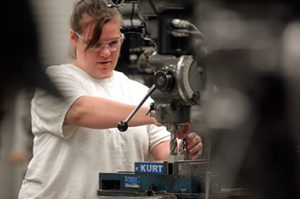January jobs report filled with positive economic news
Employers raised pay, more people felt confident enough to look for work, and the unemployment rate dipped to 4.9 percent, its lowest level since 2008.
Employers raised pay, more people felt confident enough to look for work, and the unemployment rate dipped to 4.9 percent, its lowest level since 2008.
Much of the weakness last quarter reflected a slowdown in consumer spending, which grew at an annual rate of just 2.2 percent, compared with a 3 percent rate in the previous quarter.
The U.S. economy grew at a slightly faster rate in the summer than previously reported, mainly because businesses restocked their goods at a stronger pace than first thought.
 If the U.S. economy were a compact car, it would be running on just three of four cylinders. That was the central message of a Fifth Third Bank expert at IBJ's 2016 Economic Forecast on Wednesday.
If the U.S. economy were a compact car, it would be running on just three of four cylinders. That was the central message of a Fifth Third Bank expert at IBJ's 2016 Economic Forecast on Wednesday.
U.S. hiring showed a strong downturn in September, and job gains for July and August were lower than previously thought, a sour note for a labor market that had been steadily improving.
Employers added 215,000 jobs in July and the unemployment rate held at a seven-year low of 5.3 percent, possible signs of further progress in the U.S. labor market that’s keeping the Federal Reserve on the path toward raising interest rates as soon as next month.

The rate fell mostly because many people out of work gave up on their job searches and were no longer counted as unemployed. Average hourly pay was flat.
Orders to U.S. factories for long-lasting manufactured goods fell in May, pulled down by a sharp drop in demand for aircraft. But a category that reflects business investment rose, a hopeful sign for manufacturing.
The trend indicates that employers are confident enough in future consumer demand to retain their staffs. The number of people receiving benefits fell 50,000 to 2.22 million.
The U.S. economy skidded to a near halt in the first three months of the year, battered by a triple whammy of harsh weather, plunging exports and sharp cutbacks in oil and gas drilling.
Orders to U.S. factories for long-lasting manufactured goods bounced back in January, rising by the largest amount in six months, although much of the strength came from a big jump in airplane orders.
Personal income rose 0.3 percent in December, aided by the steady wave of hiring over the past year. But rather than spend those gains, consumers saved more of their disposable income.
Suddenly robust economic growth, low unemployment and shrinking gas prices have improved the outlook of Americans, a study shows.
The sizzling rate gives credence to many analysts who think U.S. growth is finally set to accelerate. More people are working and have money to spend.
Hiring last month was broad-based but particularly concentrated in retail, temporary services and transportation and warehousing.
After Tuesday's midterm elections, exit polling showed how little falling unemployment has resonated. Most voters said they cast their ballots out of fear for the economy.
Employers have now added at least 200,000 jobs for nine straight months, the longest such stretch since 1995.
Economists from Indiana University Kelley School of Business say they are cautiously optimistic that 2015 will be the strongest year the economy has seen yet in its long, slow recovery from the Great Recession.
The number of people seeking U.S. unemployment aid dropped to the lowest level in 14 years last week, the latest sign of a strengthening labor market that could help blunt worries about the impact of weak global growth.
A survey of Harvard Business School alumni released Monday reveals a series of trends that are widening income disparities and may be weakening the ability of the U.S. economy to grow in the long term.